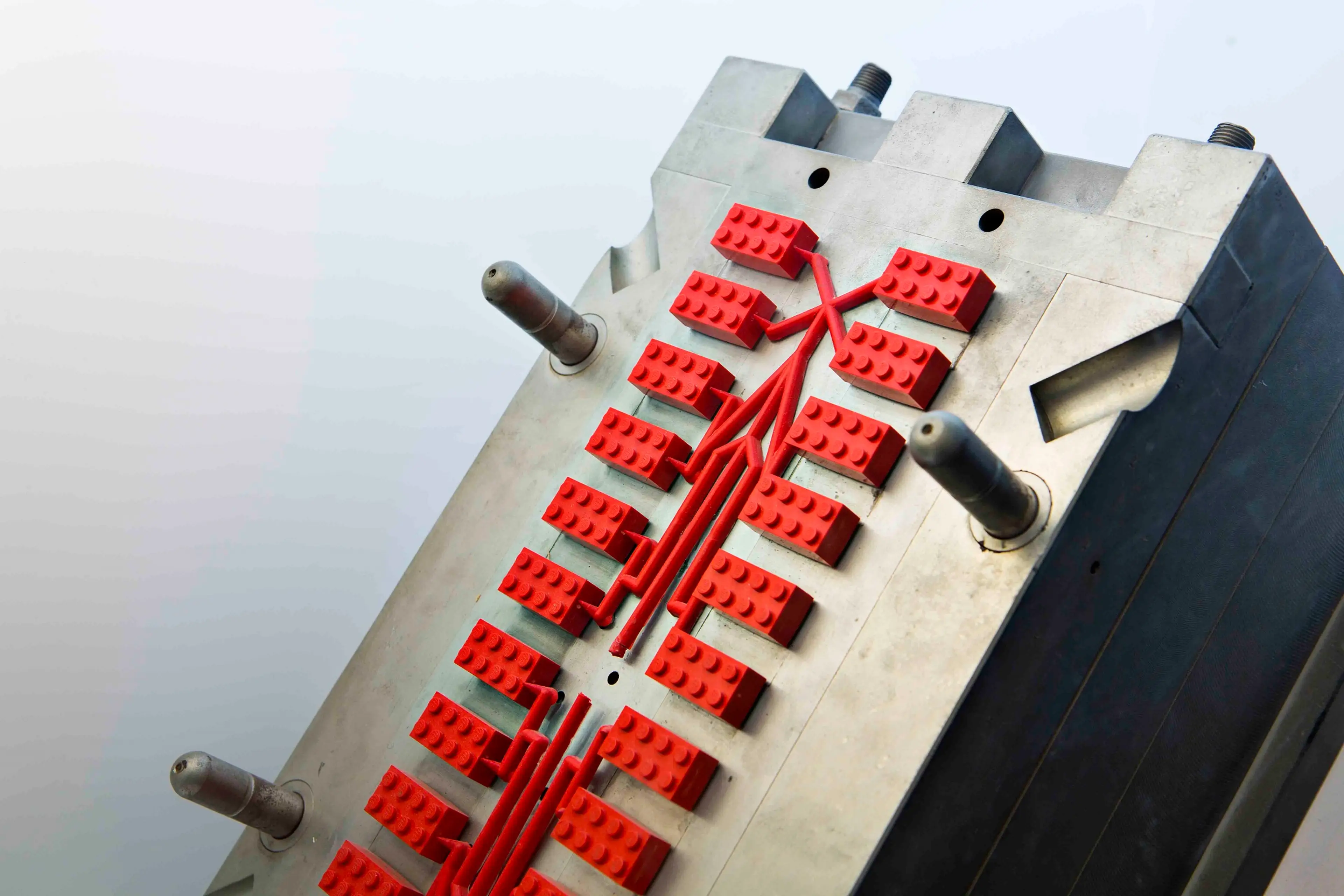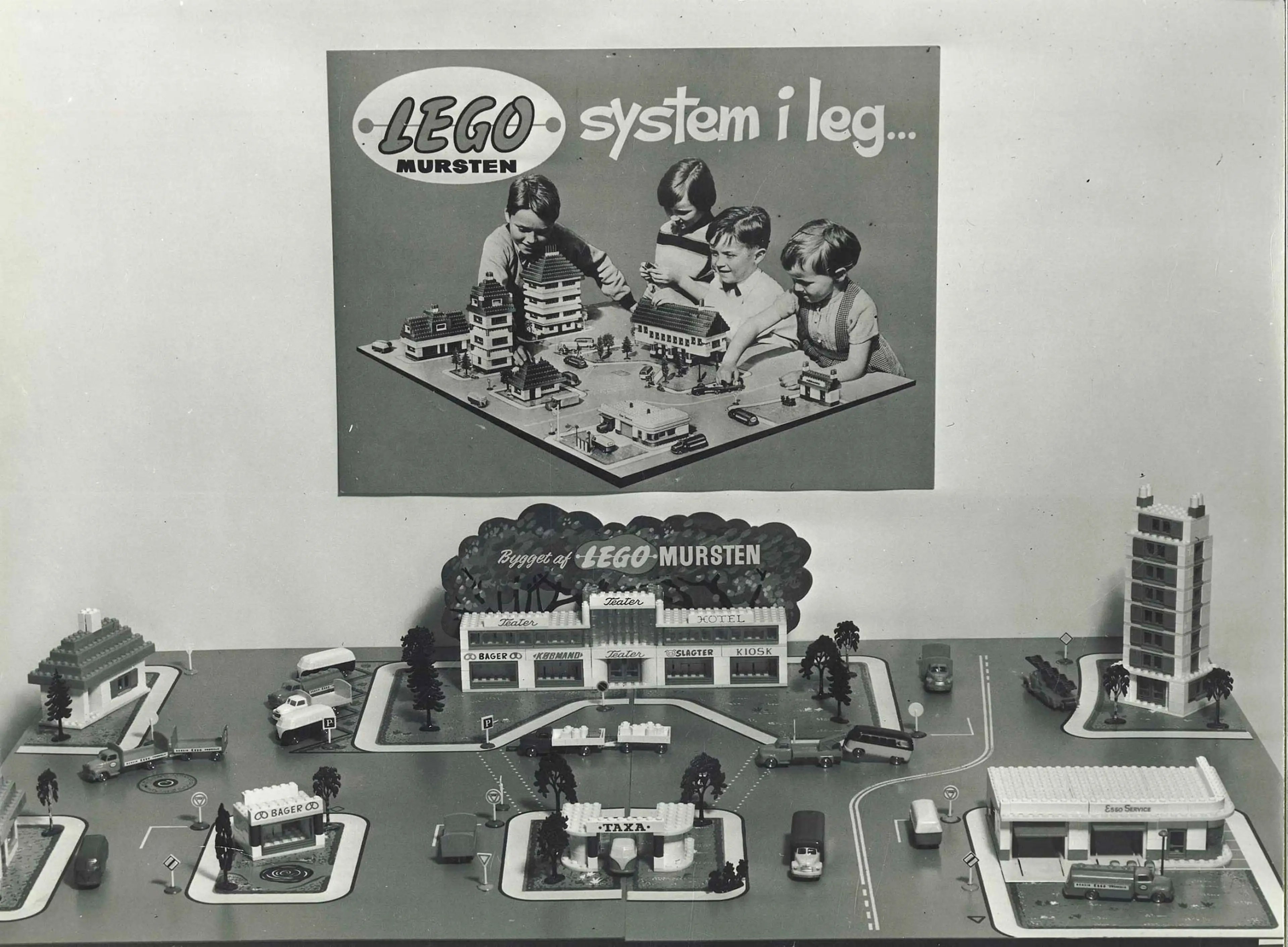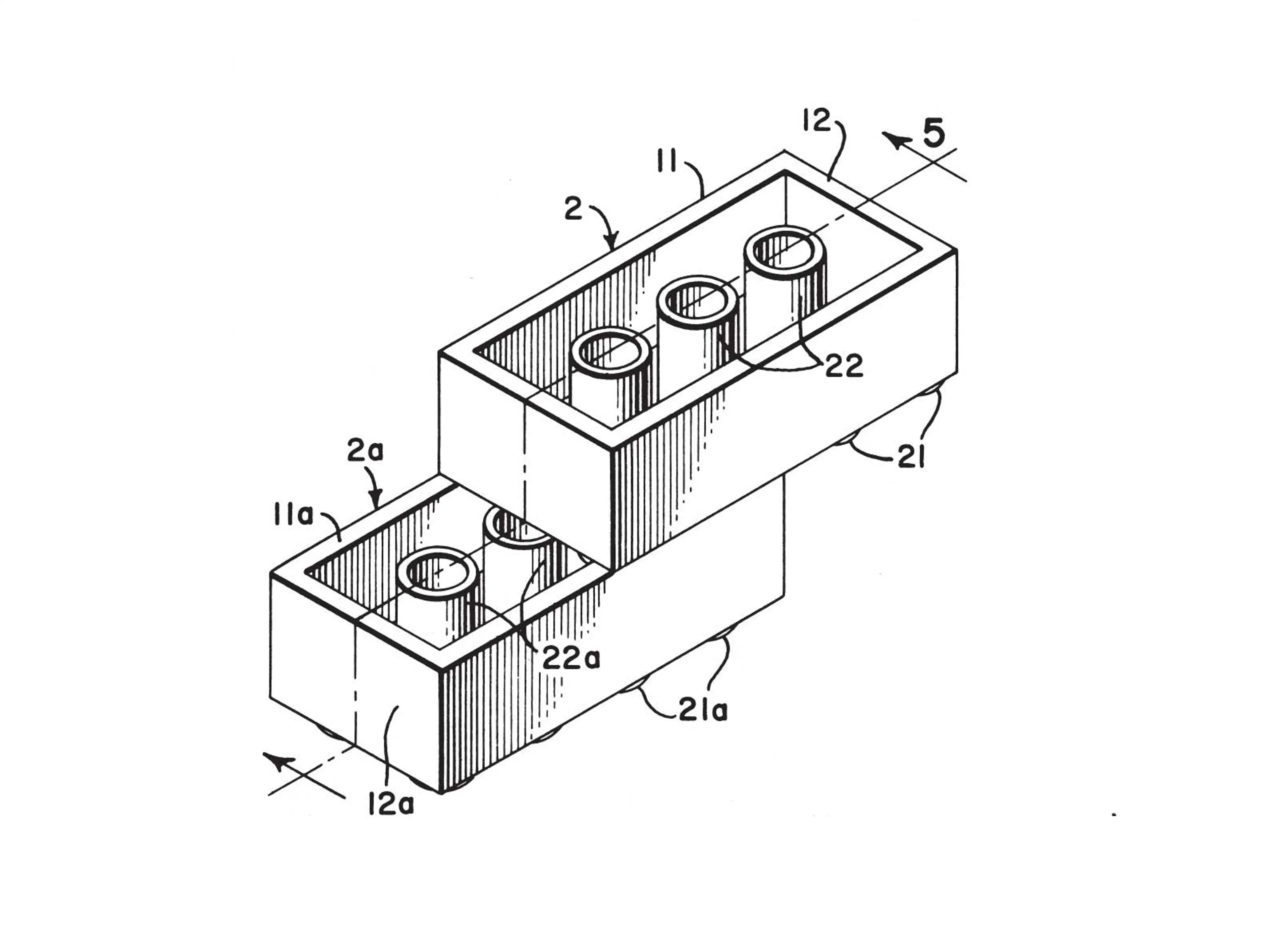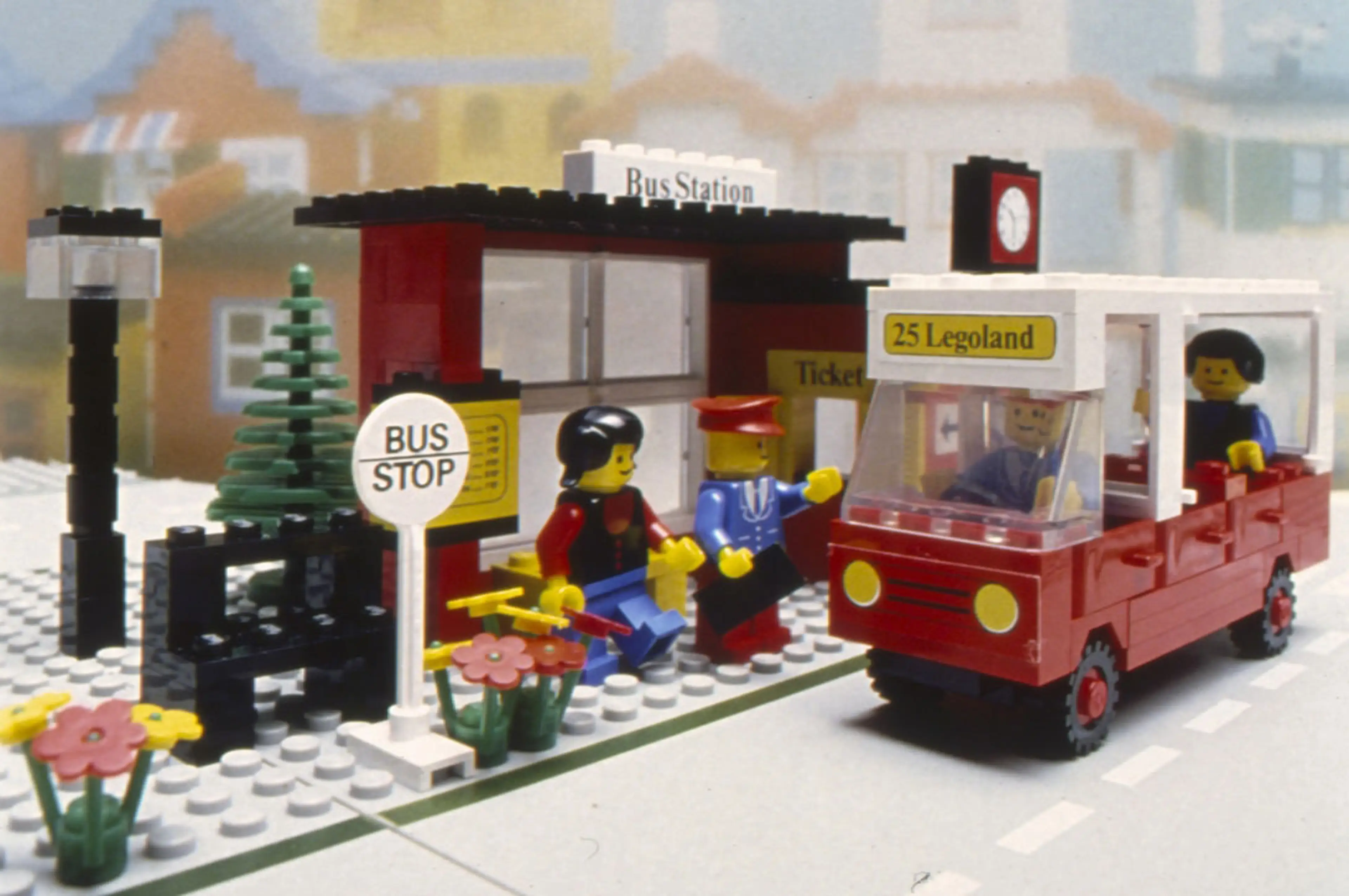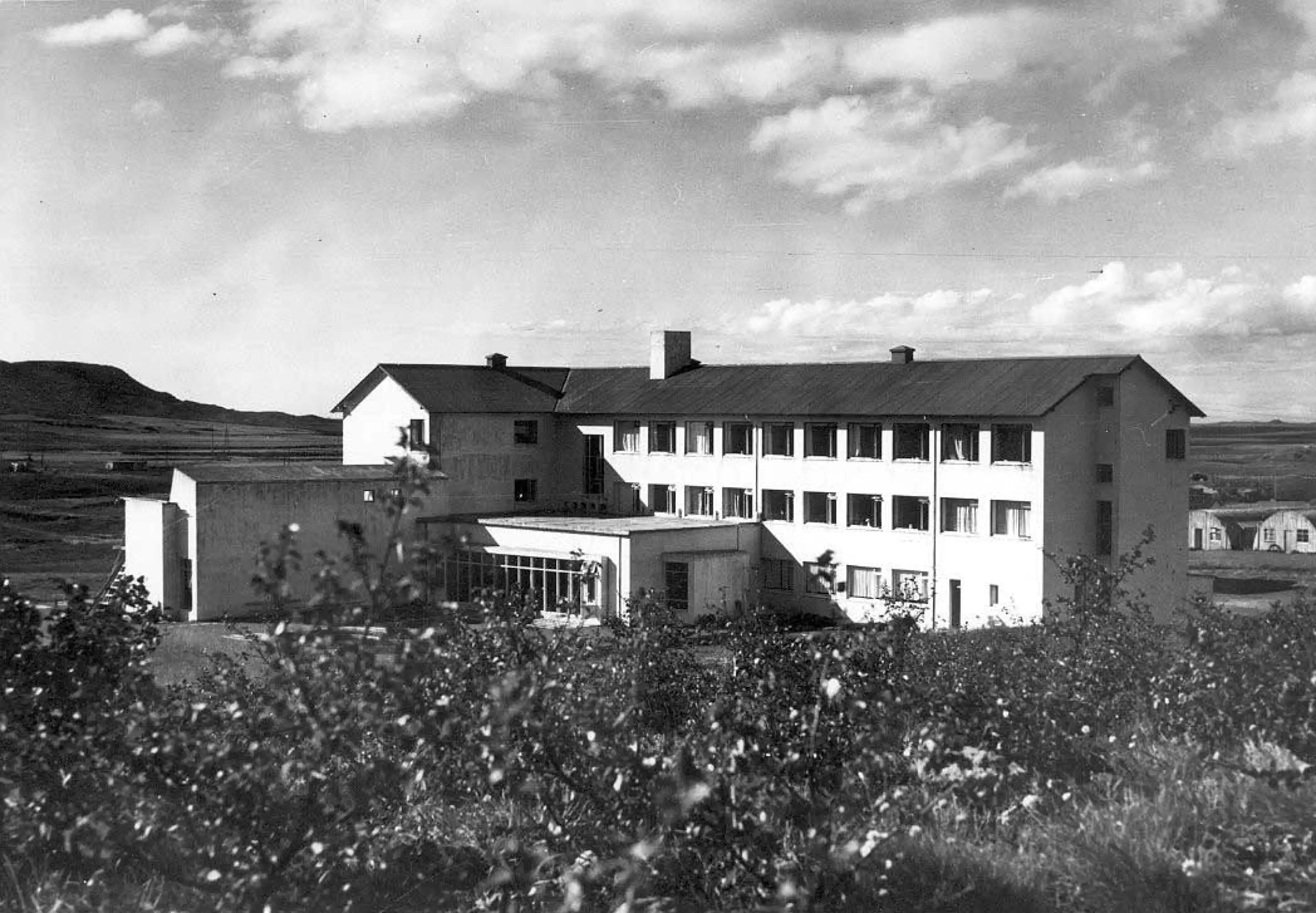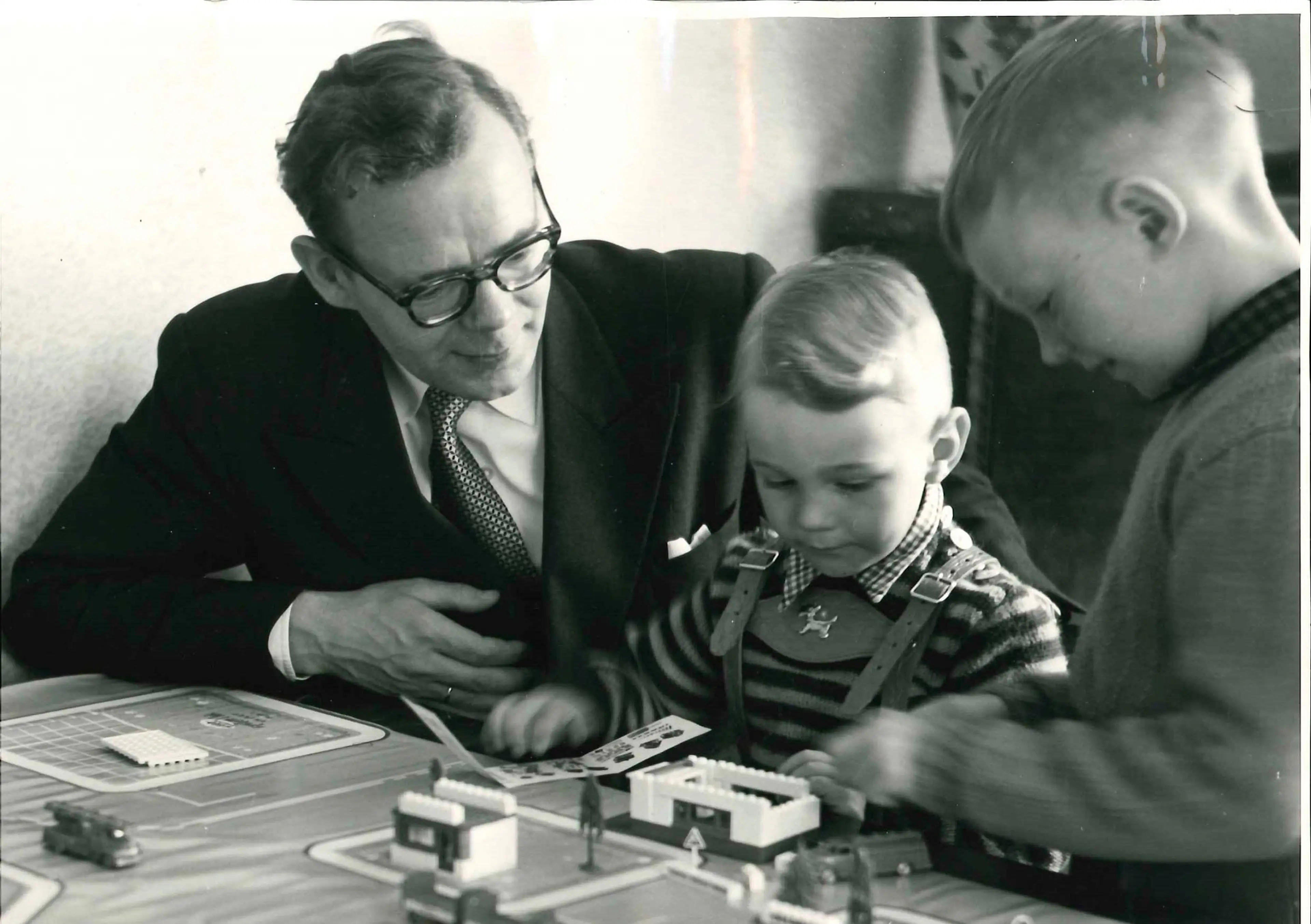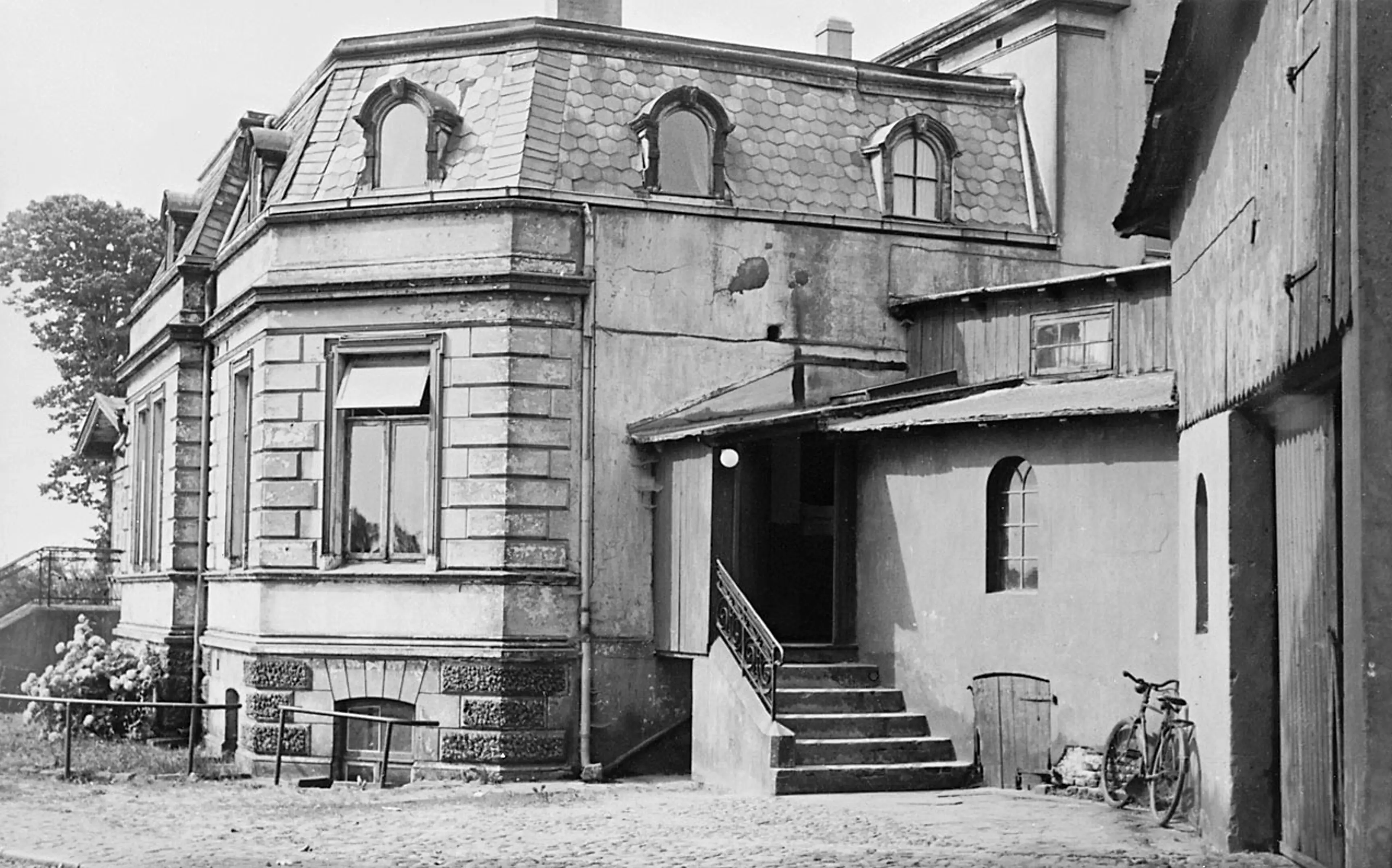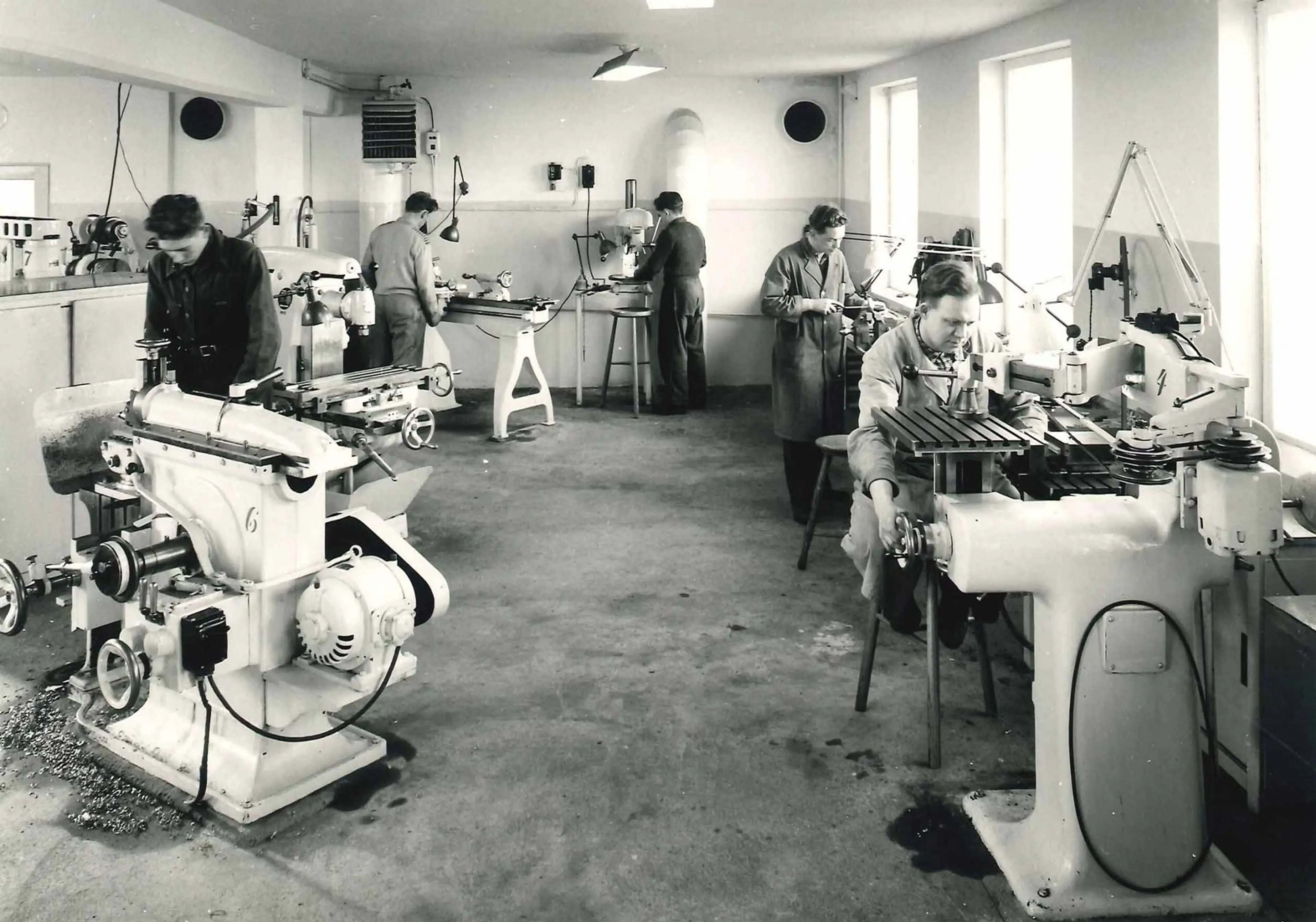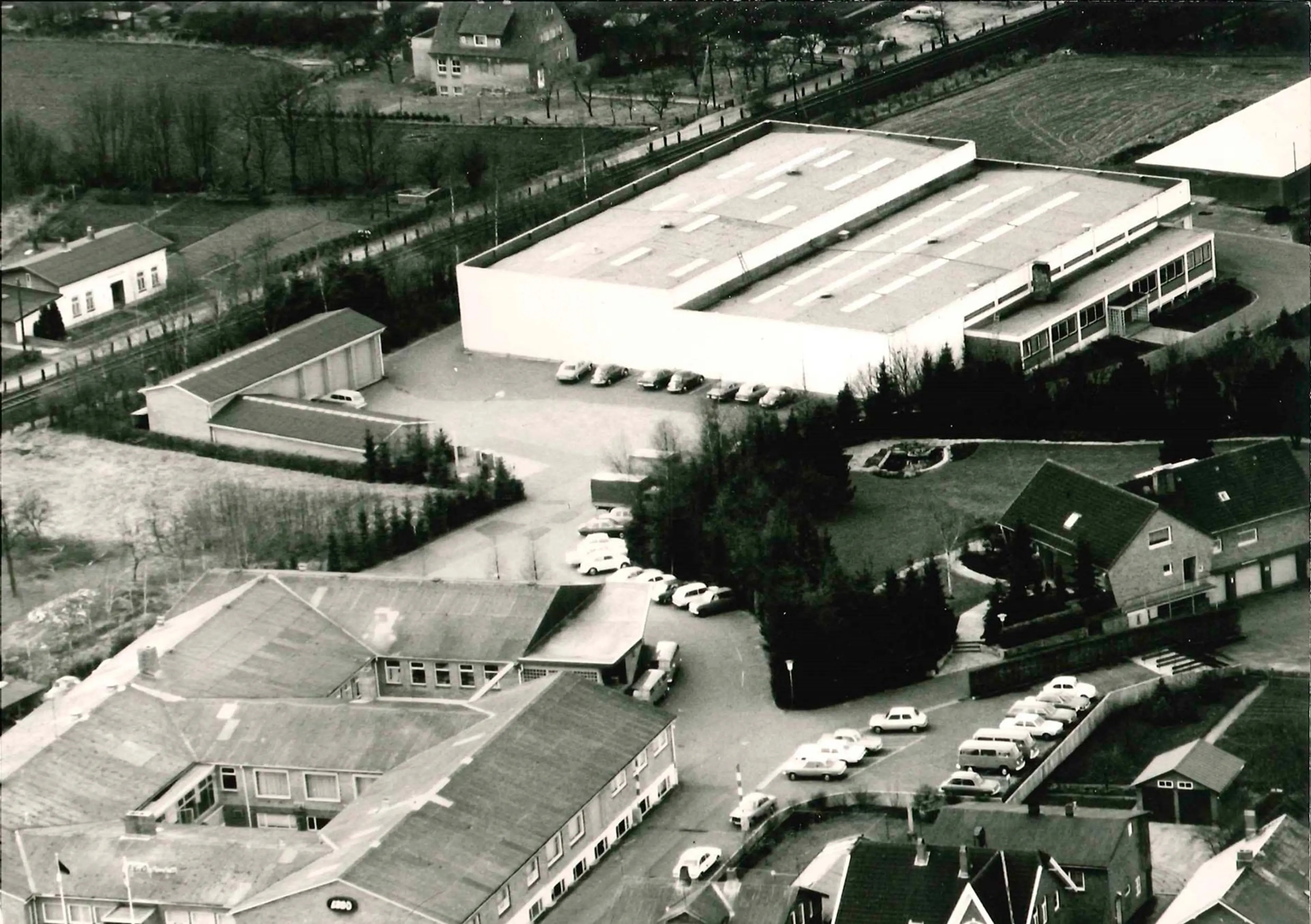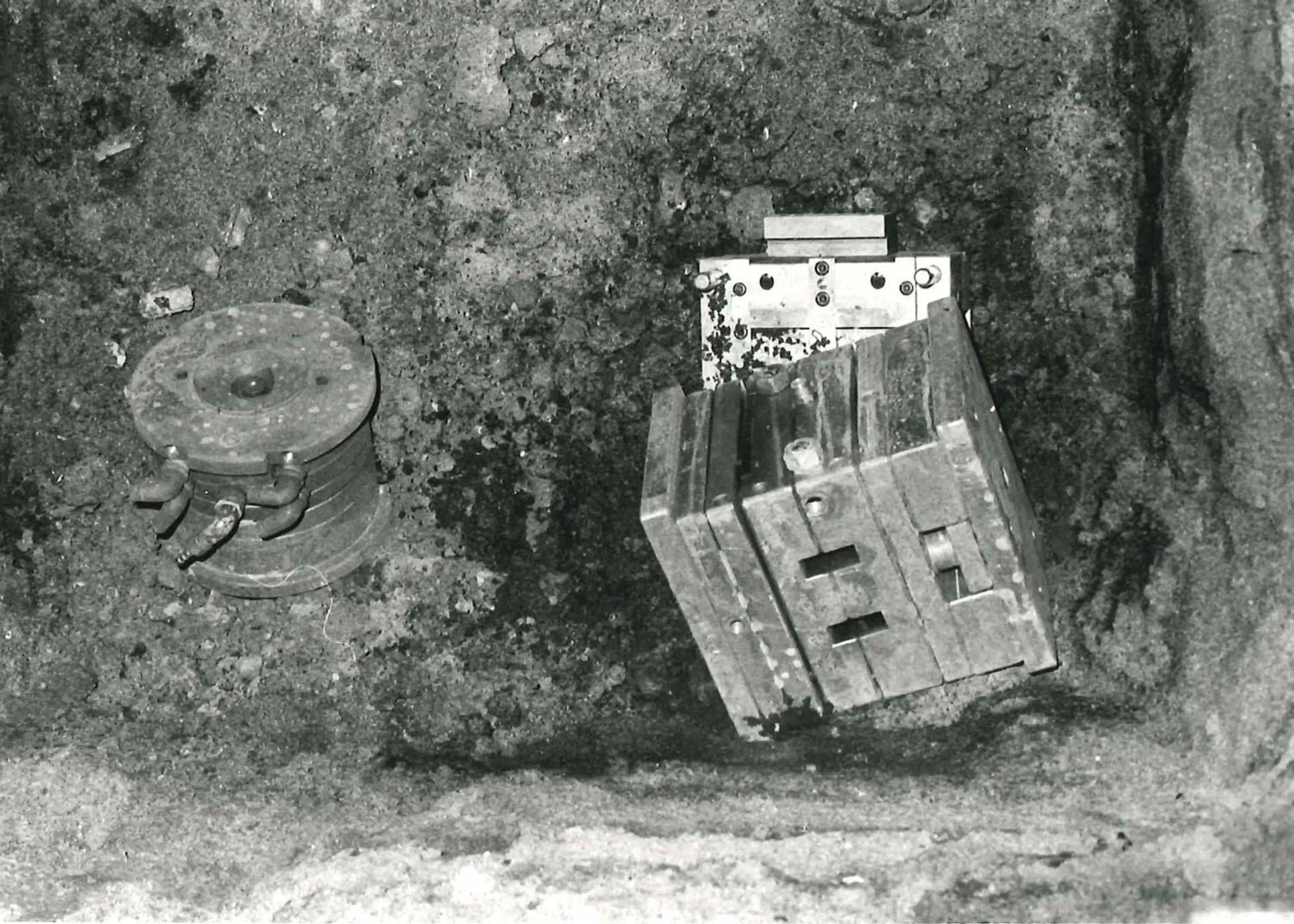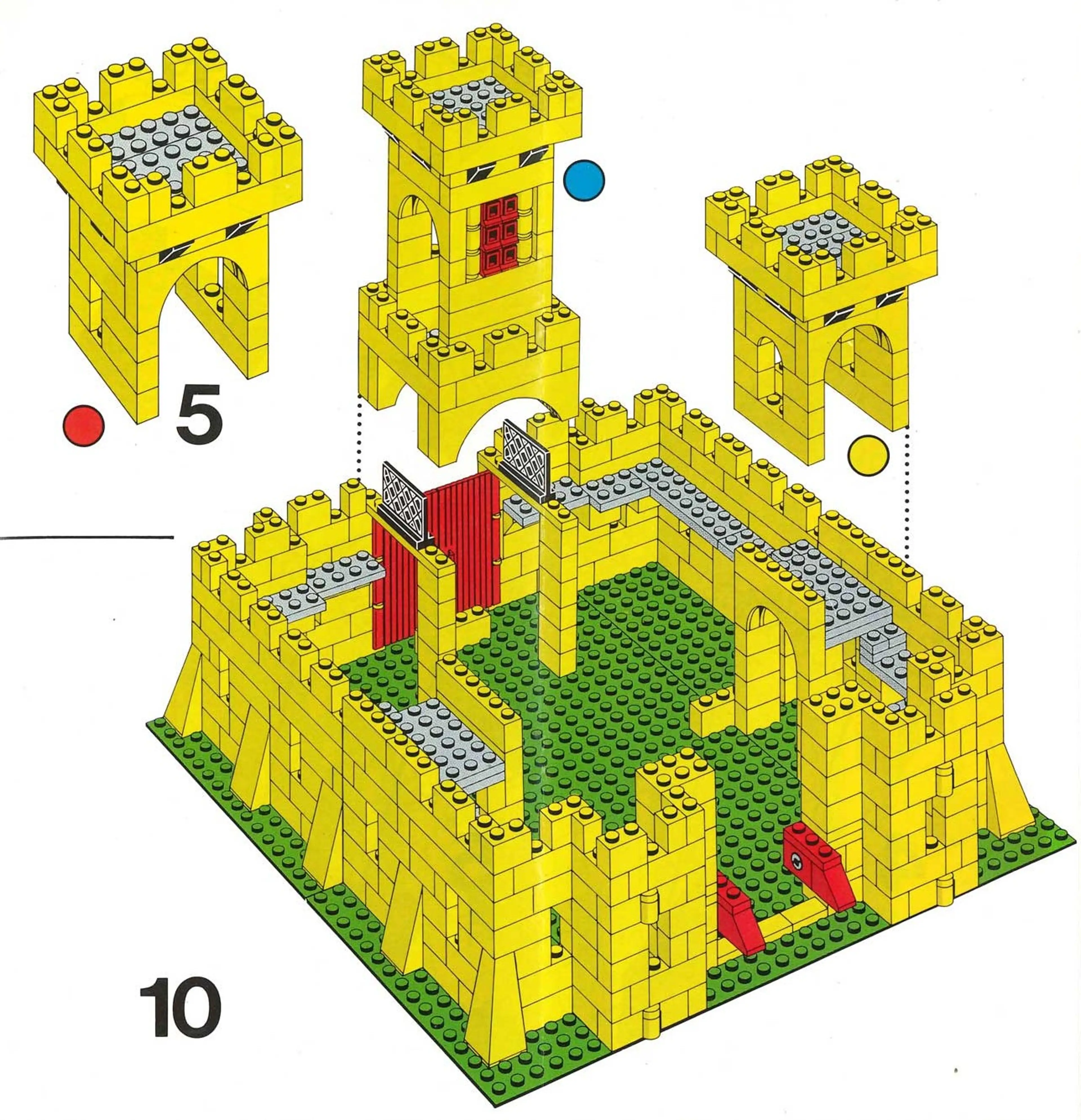Building instructions. The silent helper that without a single word guides you, step by step, to transform your pile of bricks to fantastic creations. The tool that shows you building techniques and gives you a solid foundation for further exploring the wonders of the LEGO brick. Let’s take a look at some of the many historic milestones.
Before instructions
The history of building instructions starts with very simplified instructions as early as 1955. Prior to this the only ‘guidance’ for products containing plastic bricks were drawings on the packaging to serve as inspiration for consumers. There were also examples of small leaflets with inspirational material inside some boxes in the 1950s.

Example of a set with drawings on the packaging
The company also produced more elaborate inspirational material to hand out or sell separately, the so called “byggebog”, which directly translates to ‘building book’, but perhaps a better term is idea book. The Idea book was first published in 1955 and contained among other things information on different building techniques and inspiration for building houses.
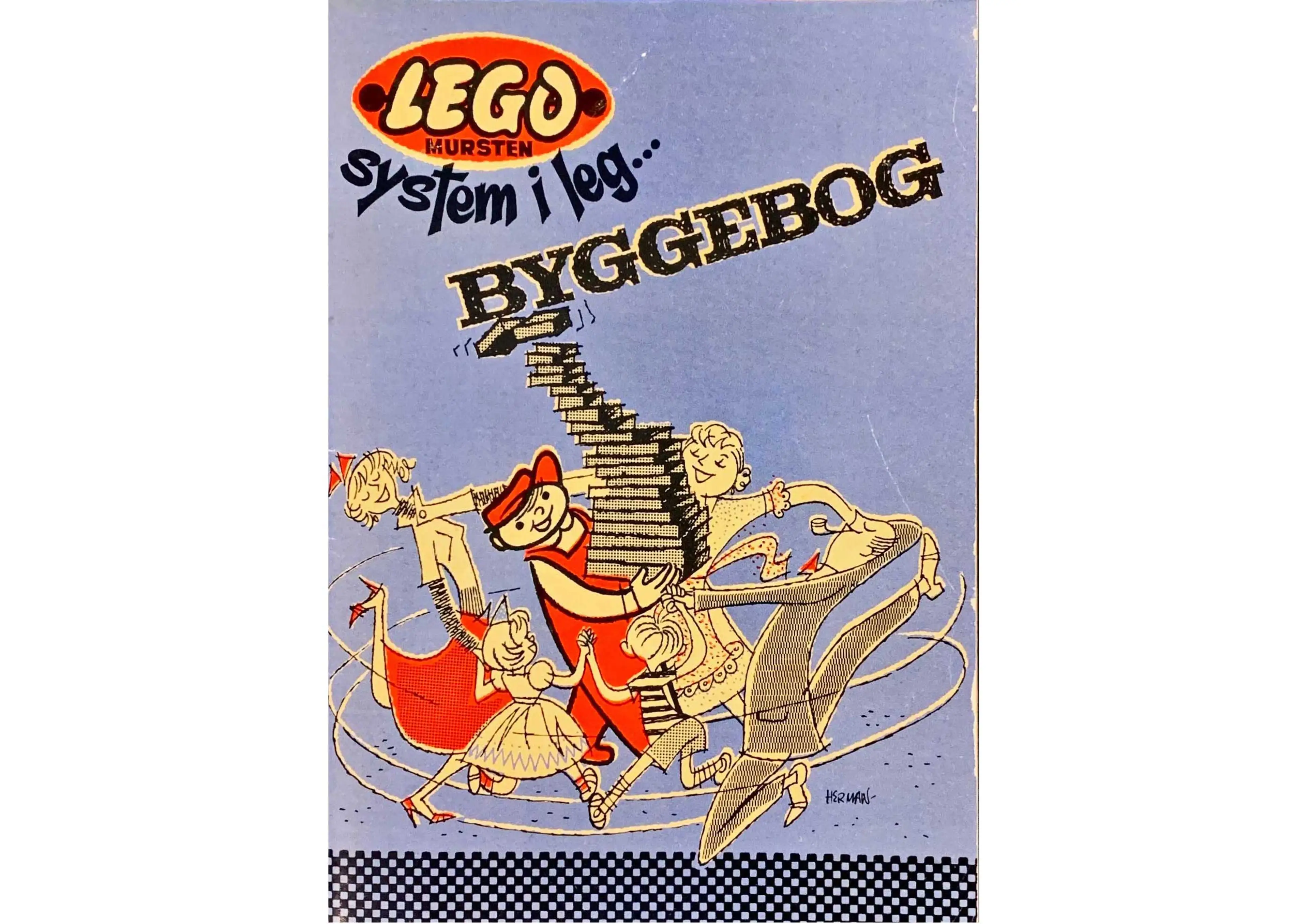
Cover of LEGO Idea book from 1955
.jpg?width=3840&quality=68&auto=webp&format=webply)
Spread from the book concerning building techniques
Early building instructions
In 1955, the LEGO System in Play idea was introduced. The groundbreaking idea that among other things makes sure the bricks you buy today will fit with the bricks you bought yesterday and the bricks you buy tomorrow. The first LEGO System in Play products were centered around a town environment (Town Plan no. 1). The town plan and the houses and shops etc. to inhabit the town was the first time the LEGO Group introduced special sets with specific models, as in, the model you saw on the box was also what you could build with the content of the box. This created a need for more instruction to make sure all consumers could reach the wanted result and thus the first simple building instructions were introduced. Although instructions for specific models started to appear there was also a focus on encouraging alternate builds as the below instructions also shows. In the text to the left, it was suggested to build the two buildings together with other buildings on the town plan to create “nice corner shops”.
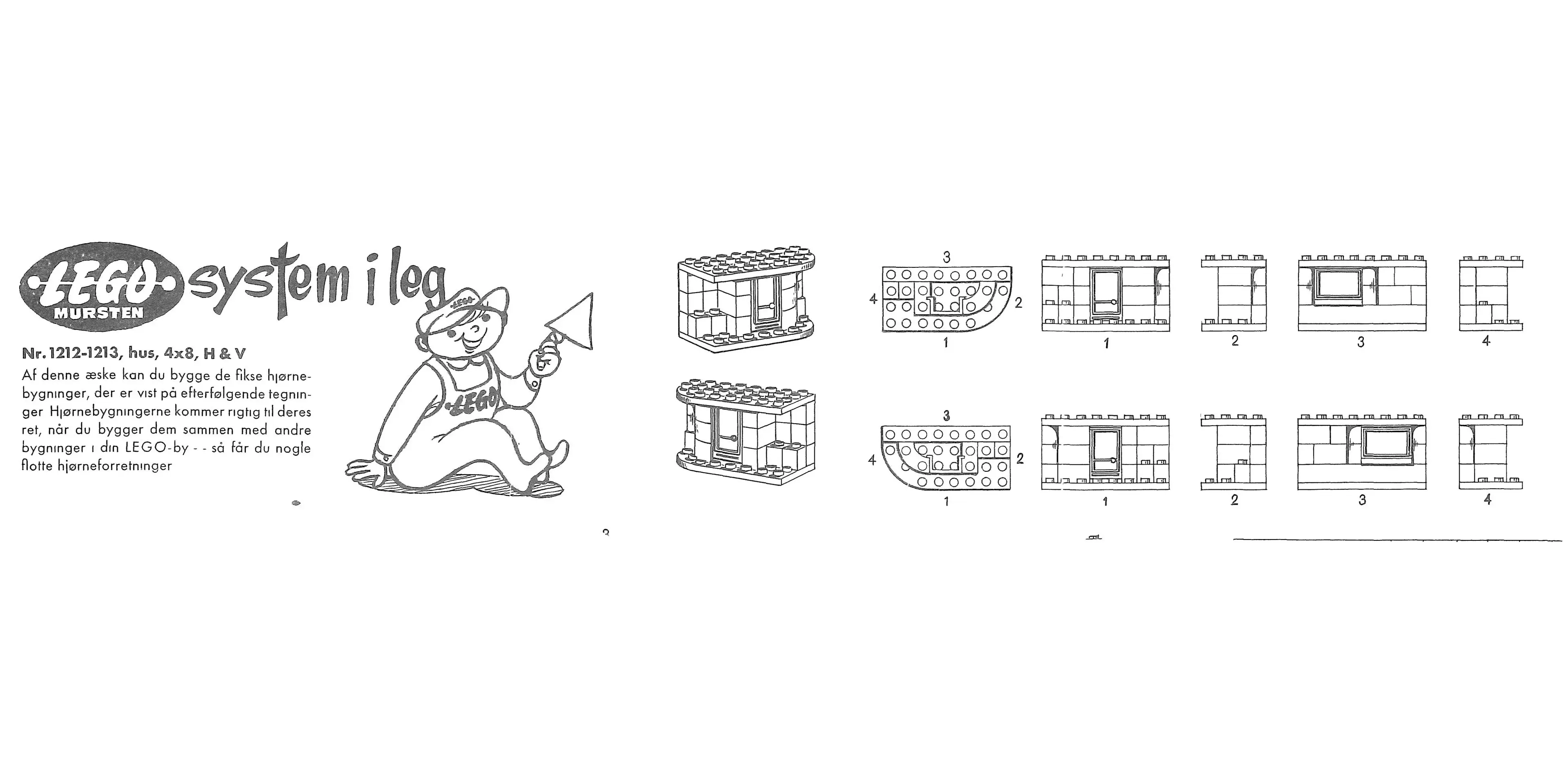
Example of a simple instruction for a 1955 set intended for the Town Plan
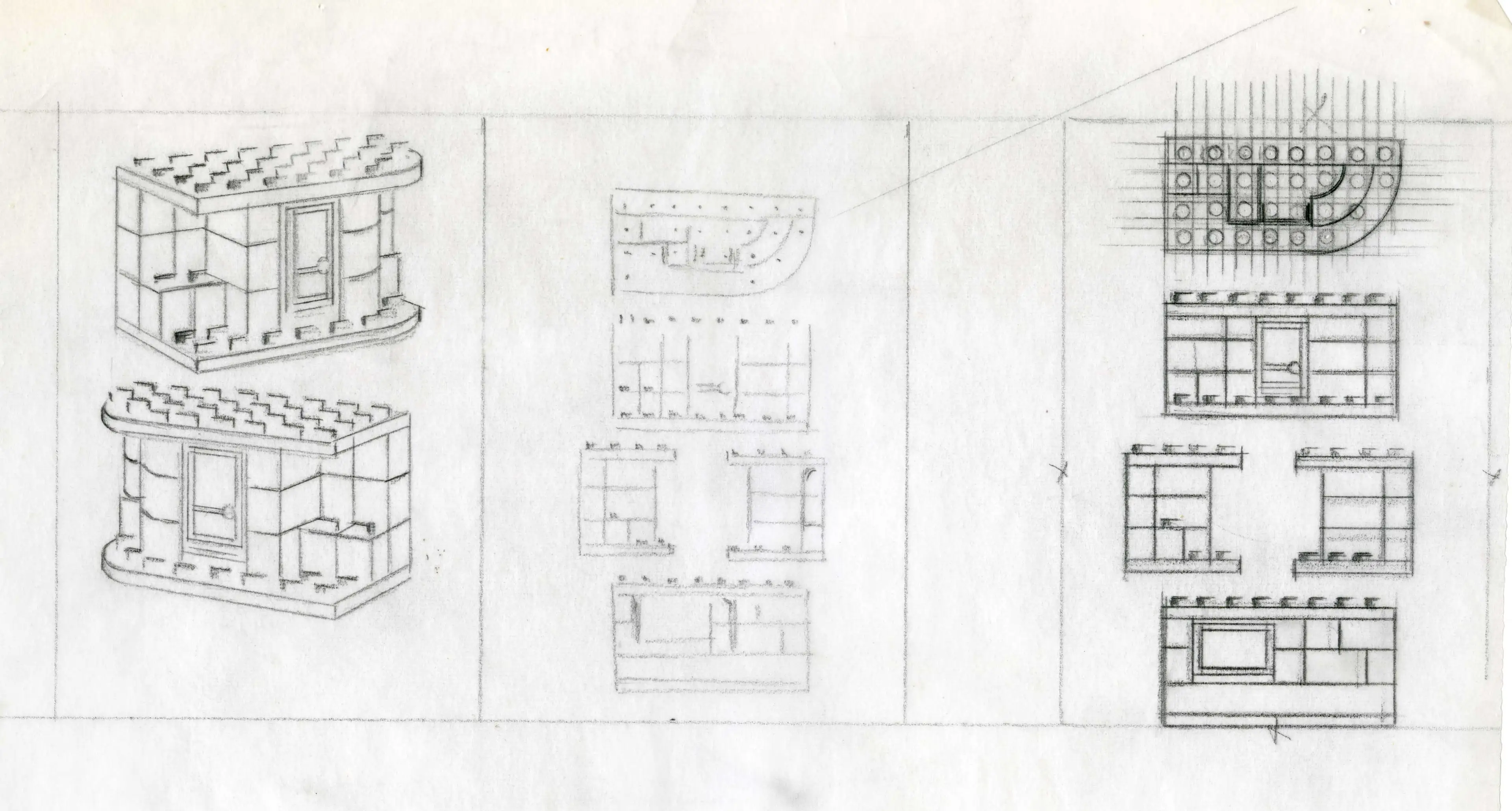
Sketches for some of these instructions found in the LEGO Group Archives suggest that these early pioneering instructions for LEGO sets were most likely made in-house
Just as the new specialized Town Plan sets with building instructions had a hint of free building/alternate builds in them, the basic sets, with a high degree of free building, started having suggestions for instructions. From 1955 onwards, simple instructions for houses were found in basic sets to serve as inspiration/play starters for consumers. This mirrors the different views present in the company at the time. For example, documents reveal an internal discussion in 1960 where the company’s management have different views on how much “help” consumers should receive when building with LEGO bricks. Should you only provide inspirational material and let children’s imagination do the rest or do you “educate” children with instructions and thus building techniques in the hope that by doing so you instill confidence in children to investigate the endless building possibilities of the LEGO system later in their play journey. The material available in the early 1960s suggests a compromise and the above-mentioned observation hints at a similar situation in the mid-1950s.
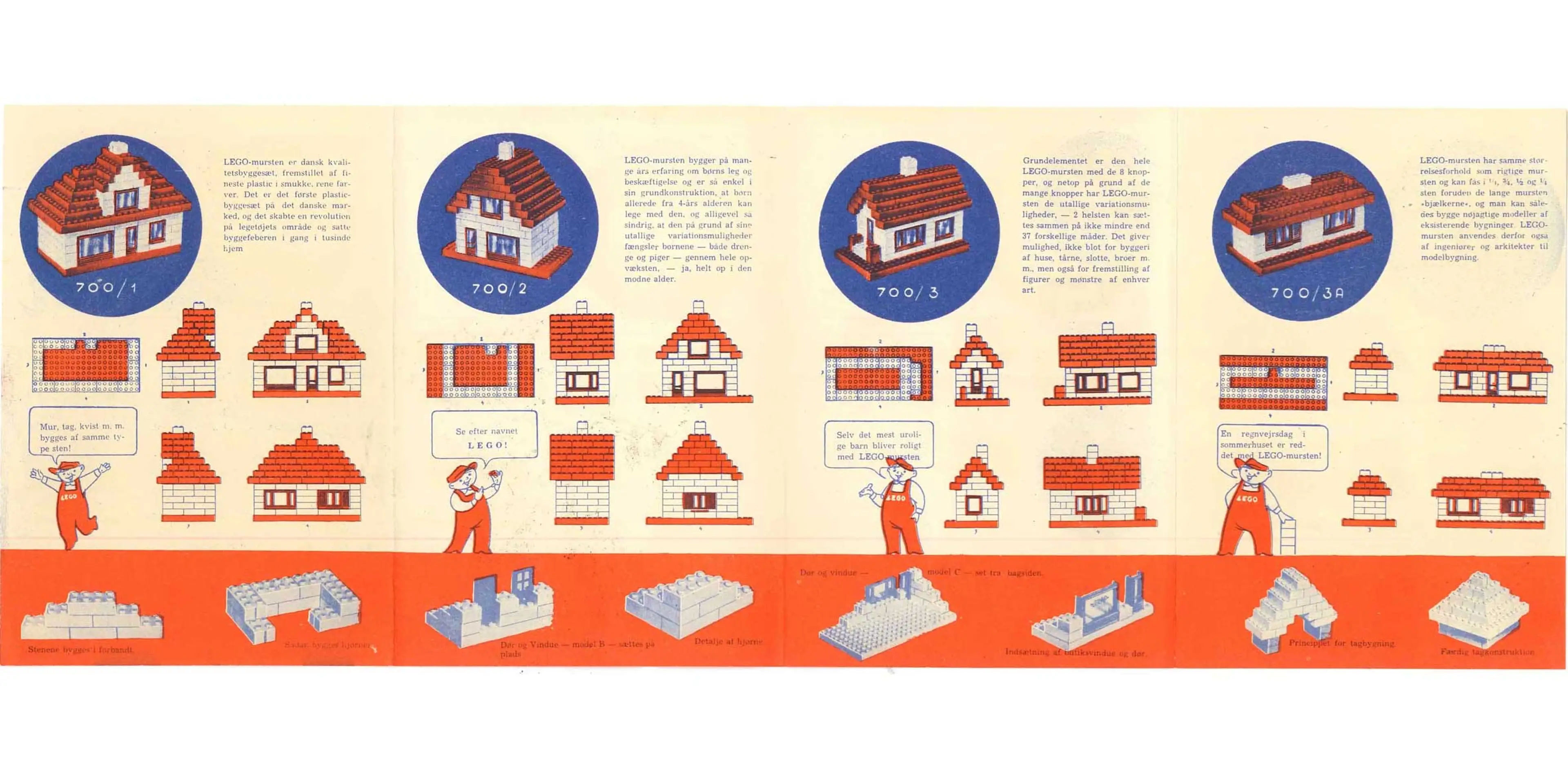
Building instructions for suggestions for houses you could build with various basic sets such as set no. 700/1, 700/2 etc.
More elaborate instructions
From the introduction of the LEGO brick, we know today, in 1958 and the much-improved stability that came with the ingenious interlocking principle, LEGO sets slowly became bigger and more detailed and this demanded a change in building instructions in the early 1960s. From then the instructions slowly started to contain more building steps than earlier, and the building experience was improved by consistently adding color to the instructions. However, the instructions were still very simplified compared to the ones we have today. The instructions would normally have two sides with one showing steps to build the model depicted on the front of the box and the other side would contain images of alternate builds. Going back to the beforementioned internal discussions it seems we are still looking at the art of compromise.
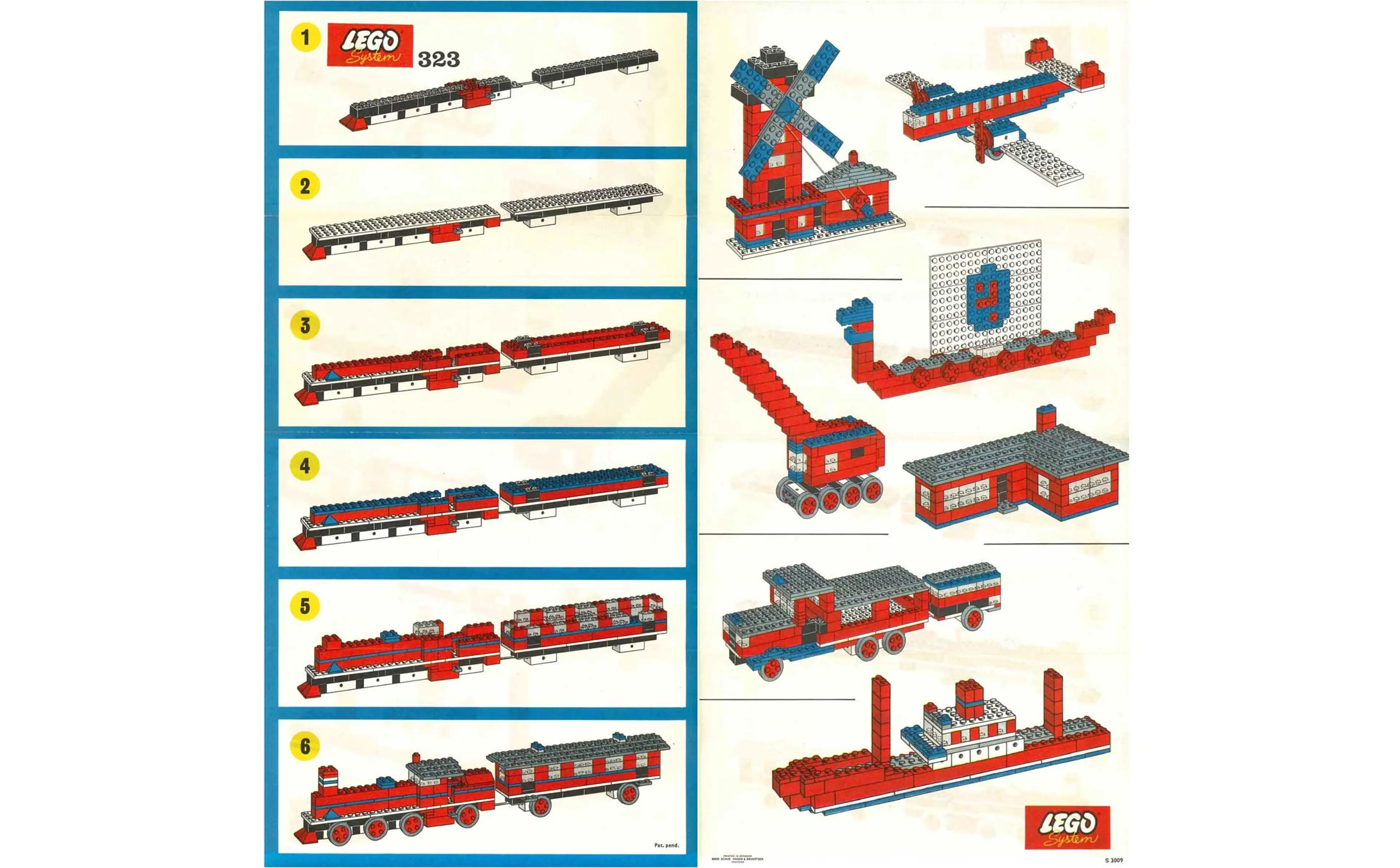
Building instruction from 1964, set no. 323, showing instructions on one side and alternate builds on the other
Although the material is scarce on the subject, the change in building instructions indicate approximately when the LEGO Group started to team up with external companies to help us draw the instructions.
We know for a fact that from 1967 and until 2003 the main supplier of drawing building steps for the LEGO Group was a company called Palle Munch, Grafisk tegnestue & Reklamebureau based in the Danish town Kolding. However, according to the owner Palle Munch, some instructions were made by another company in Aarhus, Denmark.
Creating Building Instructions
Speaking of drawing building instructions, let’s look at some of the many steps it took to create a building instruction back in the day. Making building instructions was a slow and tedious process. After the designers finished designing and building the model it would be split down into the various building steps – for many years the building steps were decided by the designers themselves. Every building step would be built and put next to each other on a table for review and approval. After being approved pictures would be taken of all the steps, one by one. Each model showing one building step was meticulously placed exactly on the same spot as the previous one and then the next step would follow. Eventually you would be able to match the pictures over each other to form a section by section building instruction. The photos were sent to external partners, like Palle Munch, Grafisk tegnestue & Reklamebureau, who then drew the building steps by hand. The drawings were made in a larger scale (each knob had a diameter of 7,5 mm) to make the detailing easier. Afterwards the drawings of the building steps were scaled down and sent to another company for the finishing touch - coloring. Palle Munch also remembers the physical building steps being shipped to him in boxes, sometimes taking up a lot of room on the company’s premises. This would happen later when Palle and his employees started using other technologies to draw the building steps…
A big change
In the early 1980s, big changes were happening in the world of LEGO building instructions. In 1983, the LEGO group sets up a specialized building instruction team for the first time who take over creating the building steps from the designers. A few years later a switch is made from hand drawn building steps to doing it in a computer-based tool instead. Palle Munch, the owner of Palle Munch, Grafisk tegnestue & Reklamebureau finds a 3D drawing tool called ‘Monster’ which originally is used to draw stage settings for Danish television. In May 1984, Palle Munch contacted the company who originally created Monster and asked them to help create a new tool suitable for drawing building instructions for LEGO sets. The project started in the fall of 1984 and the intention was to use Monster as the basis to create the new drawing tool. Quickly the company behind the original tool realized that the task of making a tool for drawing building steps required a quite substantial rebuild of Monster and it took more than a year and a half to create the new tool. The tool, eventually called ‘Panter’, was named after Palle Munch, and the name stands for “PAlles Nye TEgneRedskab” which translates to “Palle’s new drawing tool”.
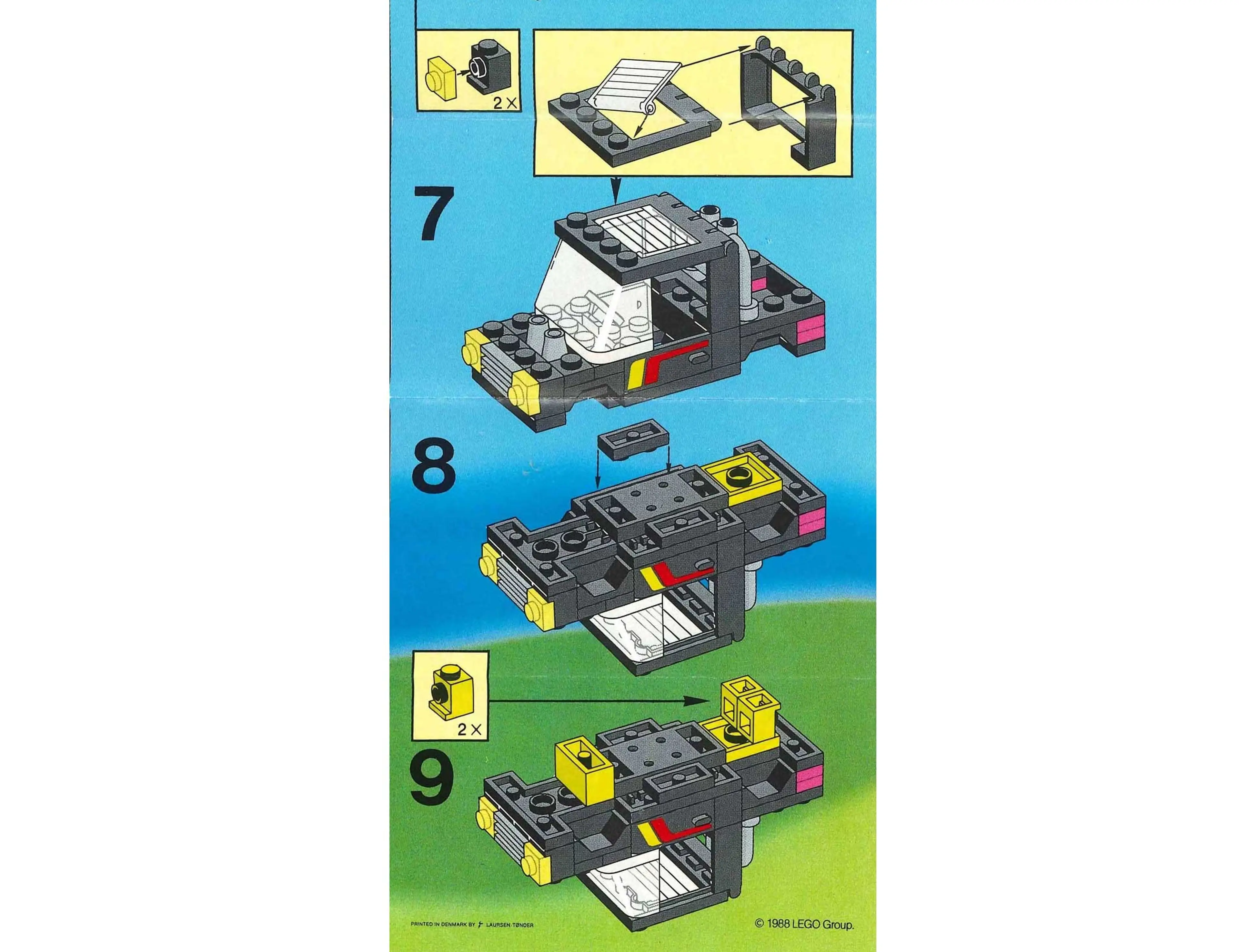
Set no. 6675 from 1988 is an example of a building instruction created with Panter
Panter was used for creating LEGO building instructions for the first time in 1986 and remained in use for the next 17 years. Although Palle Munch and his team drew the various building steps with Panter and later Panter 2, an updated tool that now included colour, it was the building instruction team in the LEGO Group that had the last say. When a new building instruction was being made, Palle Munch and team would send a test instruction to the LEGO Group for review. After review, the building instruction was changed according to the comments made by the building instruction team before the final instruction was created.
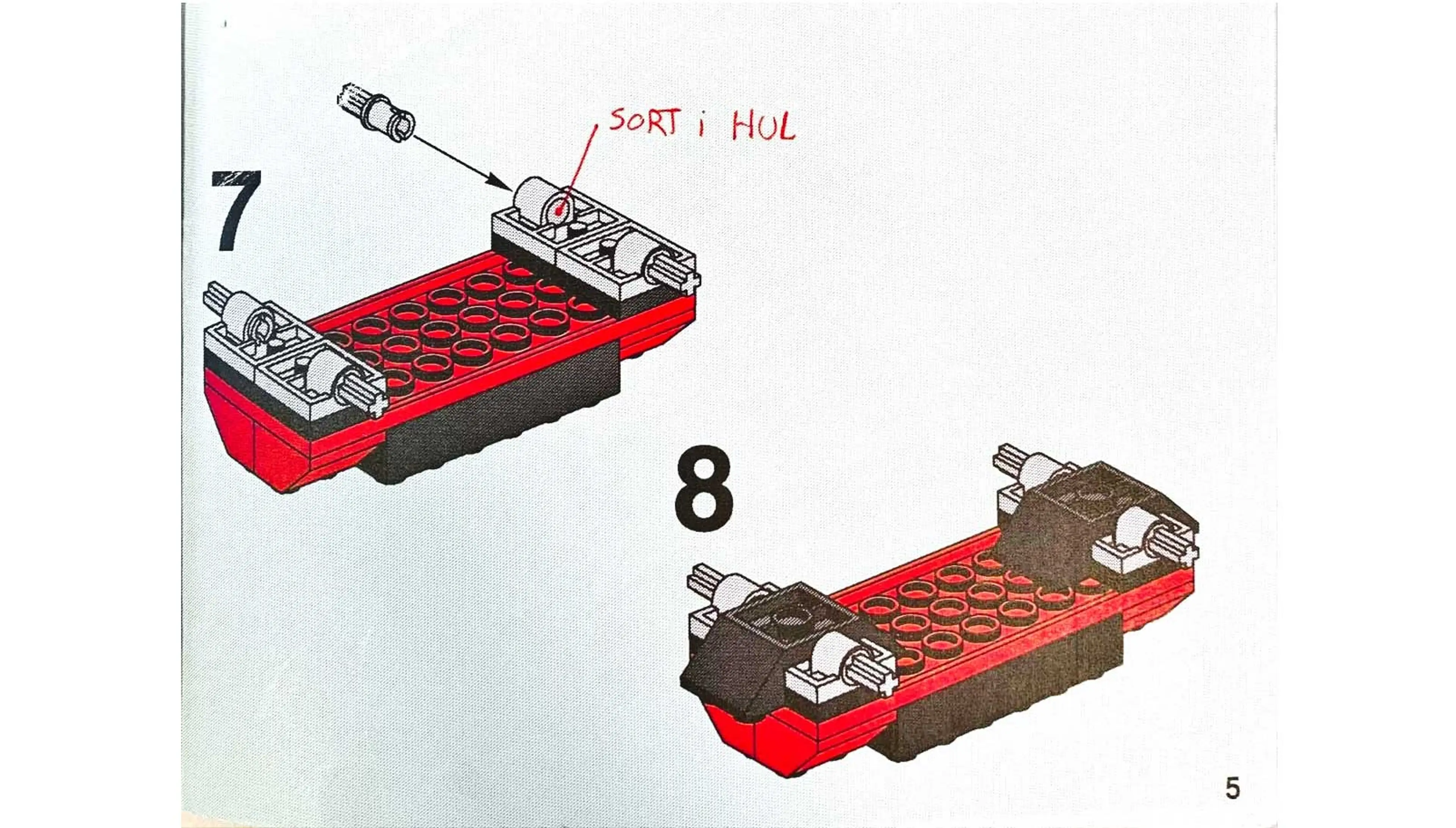
Example of a test instruction from 1998 made on Panter 2 with handwritten corrections from the building instruction team at the LEGO Group
New tools
In 2003, a new tool ‘3D Vision’ was introduced and replaced Panter. 3D Vision was considered a large step forward. The new tool was much more user friendly than Panter. With Panter a lot of data had to be added in the system manually for each individual LEGO element, but in 3D Vision this information, such as, dimensions etc. was automatically generated in the system. This made the new tool much more time efficient. In an article in an internal employee magazine in 2003, concerning the introduction of 3D Vision, it was mentioned that the new tool created a building instruction for a new LEGO Technic set in 3 days, and an employee was quoted for saying that with Panter it would have taken 3 weeks. Also, in 2003, 36 years of collaboration with Palle Munch, Grafisk tegnestue & Reklamebureau ended as the LEGO Group wanted to bring the whole process of making building instructions in house.
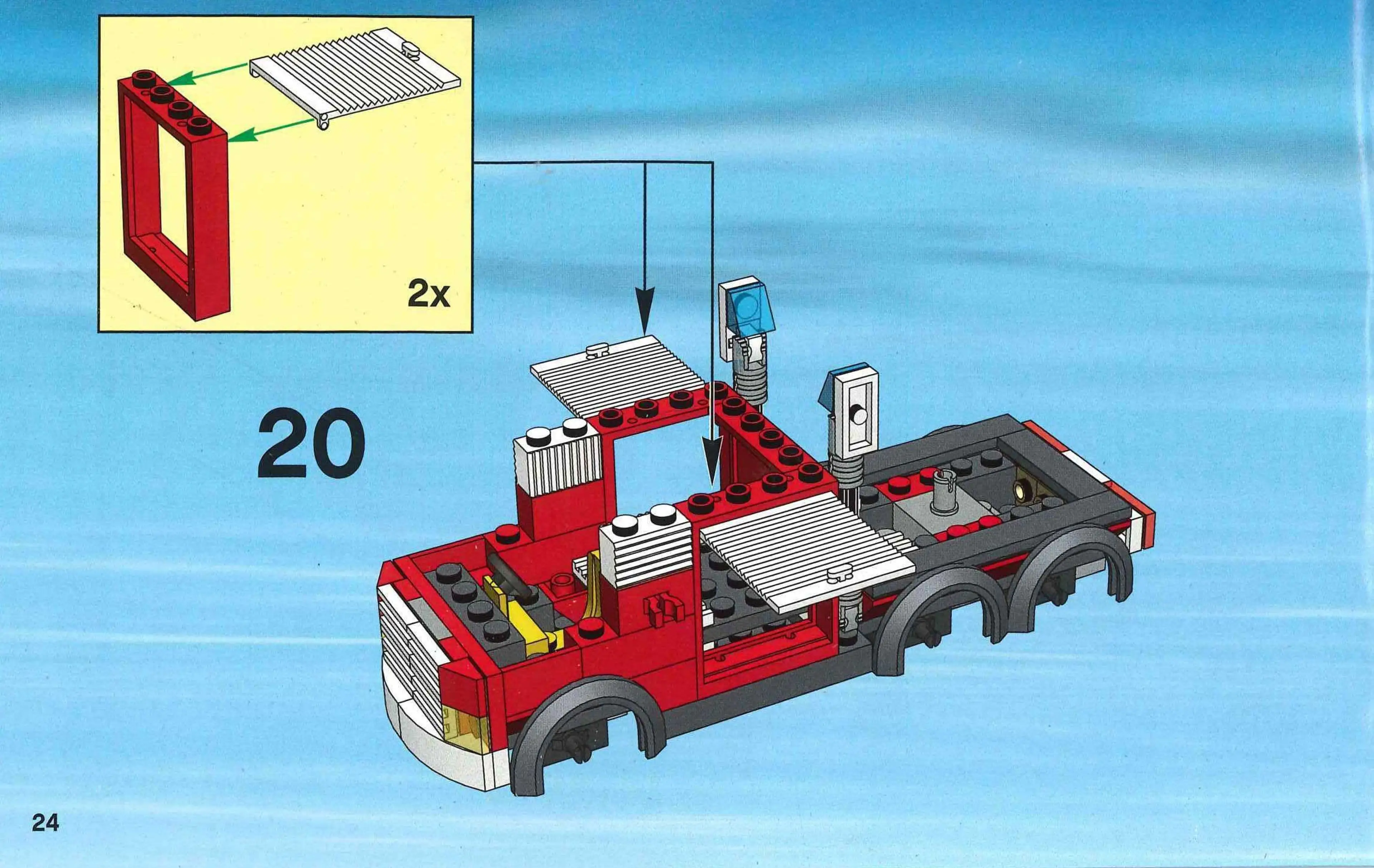
Page from a building instruction made with 3D Vision. Set no. 7239, from 2005
Approximately two years after the rollout of 3D Vision a new tool was introduced. The development of Easy Builder Tool (EBT) started in 2004 and in 2005 it was used to create the first building instructions. Contrary to 3D Vision, EBT was an internally developed tool. The tool was a plugin for an already existing externally developed 3D platform. Compared to 3D Vision the new tool came with more elaborate features but it was also known as a more complex tool to master.
.jpg?width=3840&quality=68&auto=webp&format=webply)
Building instruction from 2006 created with Easy Builder Tool
Expansion
In recent years the building instruction team has grown a lot due to, for example, a growing product portfolio. Starting with 2-3 people in 1983, the building instruction team now consists of more than 100 employees across various teams and functions. They use several tools to create the fantastic building instructions you find in LEGO sets today. One of the main tools being LEGO Digital Designer (LDD) Pro. The first instructions made with LDD Pro go back to 2018 and from 2022 all LEGO building instructions have been made exclusively with the tool. How are current building instructions made you ask? Well… that is a business secret!
Which is which?
Throughout this article, examples have been shown of building instructions made with the different tools we have had over the years. If you are struggling to see a difference in the different instructions from different time periods you are not alone. The “cartoonish” look of the instructions is something, with a few exceptions, we have always aimed for. The simple reason being that it works, and you can easily distinguish various colors and shades from each other. A LEGO building instruction is not about portraying the model as lifelike as possible, it is about creating the best possible building experience.
LEGO Builder
Since the 1950s LEGO building instructions have been a paper-based friend in need for consumers wanting help to tackle the vast possibilities of the LEGO system in Play. Today, building instructions are more than ‘just’ paper instructions. They can also be experienced through the LEGO Builder app giving consumers, no matter their experience level, an easy and intuitive building experience. In the app you will find instructions in both 2D and 3D. The latter allows you to zoom and rotate to view your build from all sides. One of the most intriguing features is unlocked when you press the ‘build together’ button on select sets in the app. This allows consumers to build a LEGO set as a team by delegating each builder a building task to complete. There is a place for everyone, no matter what skill level you have, and the feature is a fantastic tool for family quality time or teambuilding.
Relentless pursuit
LEGO building instructions have come a long way from the simple instructions in 1955 to LEGO Builder, but to this day one thing has never changed… The relentless pursuit from dedicated employees towards worldclass intuitive building instructions aimed at creating a solid foundation for LEGO builders to further explore the LEGO system in Play.
